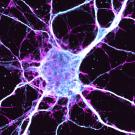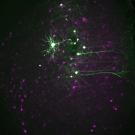
How Mark Mascal Hopes to Change the Medicinal Cannabis Landscape
When Mark Mascal first heard about the legalization of medical marijuana, he was skeptical. In a TedxUC Davis talk back in 2022, he told the audience, “I used to joke, what’s next? Medical cocaine?”
But then Mascal, a professor in the Department of Chemistry at the College of Letters and Science at UC Davis, heard the story of Charlotte Figi, a young girl who suffered from Dravet syndrome, a form of pediatric epilepsy characterized by grand mal seizures. Such seizures are often resistant to anticonvulsant drug therapy.
“By the age of five, Charlotte used a wheelchair and couldn’t speak, and it got so bad that her parents, when she was in the hospital, actually signed a do-not-resuscitate order,” Mascal said in his talk. “But about the same time, her parents also heard some anecdotal evidence about the potential effectiveness of cannabis to treat Dravet syndrome.”
Desperate, Charlotte’s parents dosed her with cannabis oil. The outcome in Mascal’s words was a “medical miracle.”
“Charlotte went from having 300 seizures a week to only a few a month and most of those in her sleep,” he said.
Though Charlotte eventually passed away in 2020 due to complications likely related to COVID-19, her story changed Mascal’s perceptions about cannabis and the efficacy of CBD as a treatment for various medical conditions, including cancer, neurocognitive disorders, muscle spasticity and autoimmune disorders, among others.
Recently, Mascal was awarded the Dr. Mohsen Najafi Research Award in Medicinal Chemistry for his research on “pseudocannabinoids,” which are synthetic molecules that mimic the action of cannabinoids.
“Pseudocannabinoid means that it’s not a natural cannabinoid,” Mascal explained in an interview with L&S Magazine. “It may be close, or it may be quite far, structurally, but it’s never going to have the regulatory hurdles that you have with cannabis research.”
The $30,000 Najafi award supports medicinal chemistry research related to neurological disorders, like Alzheimer’s disease and related conditions. The goal is to move the needle on proof-of-concept research, bolstering the case for additional research funding from sources like the National Institutes of Health.
Alternatives to cannabinoids
At the federal level, cannabis, and its constituents like CBD, is still a Schedule I controlled substance. This classification introduces regulatory barriers, including attaining licenses from the U.S. Drug Enforcement Administration, for researchers looking to work with the drug.
Mascal sought alternatives and found candidates in pseudocannabinoids like H2CBD and H4CBD, among others. Unlike CBD, these compounds can’t be converted into THC, the psychoactive constituent of cannabis. Additionally, and meshing with Mascal’s sustainability mindset, pseudocannabinoids can be completely synthesized from commercially available chemicals without the need for cultivating hemp, which can be land-, water- and energy-intensive.
But are pseudocannabinoids as effective as CBD?
In research published in 2019 in Scientific Reports, Mascal and colleagues tested H2CBD’s efficacy in treating seizures in rats against treatment involving herbal CBD. The team found that H2CBD was equally effective as CBD, reducing both the frequency and the severity of seizures.
In 2023, Mascal and colleagues published research in the American Journal of Physiology-Regulatory, Integrative and Comparative Physiology that showed that H4CBD improves glucose response in rats suffering from age-associated metabolic dysfunction. Age-associated metabolic dysfunction increases the risk of developing obesity and type 2 diabetes, among other disorders. During the study, rats treated with H4CBD reduced their body mass by roughly 15%.
Across the board, Mascal and his lab are performing structure-activity studies on pseudocannabinoids of interest to see if they can increase their therapeutic potency. In addition to seizures and metabolic syndromes, the team is looking at using pseudocannabinoids to aid in muscle recovery, pain mitigation and, with funding from the Najafi award, cognitive decline.
The Najafi award will fund Mascal’s proof-of-concept research on a new pseudocannabinoid-antioxidant conjugate that has shown strong binding to proteins associated with Alzheimer’s and Parkinson’s diseases. The researchers hope the molecule will prove active in animal models of these conditions.

From lab to market
Mascal is driven by a desire to see his research make a difference in the world.
“We want to work on molecules that can penetrate into countries where the herbal cannabinoids are illegal,” he said. “Children all over the world die from Dravet syndrome. Let’s make something that’s legal and safe for them also to use.”
To help bring the research to reality, Mascal founded the company Syncanica Bio to commercialize technologies used in the pseudocannabinoid synthesis process.
“We’re making molecules, and in research chemistry, you’re pushing the frontiers of knowledge forward,” Mascal said. “You’re making things that nobody’s ever made before and you never know, it could be the next big, important therapeutic.”
“The idea,” he added, “is to take over the CBD market with something that is safer, something that’s greener, something that’s legal, and something that’s better.”

YOU MAY ALSO LIKE THESE STORIES

UC Davis Researchers Achieve Total Synthesis of Ibogaine, Creating Opportunities to Study Its Therapeutic Properties
In a study appearing in Nature Chemistry, researchers at the University of California, Davis Institute for Psychedelics and Neurotherapeutics (IPN) report the successful total synthesis of ibogaine, ibogaine analogues and related compounds from pyridine — a relatively inexpensive and widely available chemical.

Anti-Anxiety and Hallucination-Like Effects of Psychedelics Mediated by Distinct Neural Circuits
New research shows that the anti-anxiety and hallucinogenic-like effects of a psychedelic drug work through different neural circuits. The study, in a mouse model, shows that it could be possible to separate treatment from hallucinations when developing new drugs based on psychedelics.
